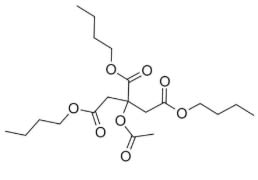Enhanced TDS
Identification & Functionality
- Blend
- No
- CASE Ingredients Functions
- Chemical Family
- Chemical Name
- Country of Origin
- Function
- Plasticizer
- Industrial Additives Functions
- Plastics & Elastomers Functions
- Product Code
- MITM09151
- Single Ingredient
- Yes
- Synonyms
- Acetyltri-N-Butyl Citrate, Sculpey Clay Softener, Tributyl Citrate Acetate
- Technologies
- Product Families
- Chemical Structure

Features & Benefits
- CASE Ingredients Features
- Industrial Additives Features
- Labeling Claims
- Materials Features
- Product Benefits
- Non-phthalate chemistry
- Not a volatile organic compound (VOC)
- Rapidly biodegrades in soil.
- 34% bio-based content
- Compatible with a wide range of polymer resins, including bio-based and biodegradable chemistries
Applications & Uses
- Applicable Processes
- Compatible Polymers & Resins
- Fragrances & Perfume Applications
- Plastics & Elastomers End Uses
- Markets
- Applications
- Product Applications
- Polymer processing
- Films and coatings
- Adhesives
- Plastisols
- Food contact films
- Childrens toys
Properties
Packaging & Availability
- Packaging Type
Principal Information
- Group Principal Number
- S002899
- Principal
Other
- Appearance
- Clear oily liquid
- Appearance (SDS)
- Clear oily liquid
- Color (SDS)
- Colorless
- IATA/ICAO Proper Shipping Name
- Not Applicable
- IATA/ICAO UN Number
- Not Applicable
- IMO/IMDG Proper Shipping Name
- Not Applicable
- IMO/IMDG UN Number
- Not Applicable
- Item Number
- Odor (SDS)
- Very slight
- Temperature Control
- No
- USA/DOT Proper Shipping Name
- Not Applicable
- USA/DOT UN Number
- Not Applicable
- Physical Properties
Value Units Test Method / Conditions Molecular Weight 402.5 g/mol g/mol Pour Point -59.0 °C °C Solubility in Acetone max. 0.1 g/100mL g/100mL at 25°C Solubility in Ethanol max. 0.1 g/100mL g/100mL at 25°C Solubility in Isopropanol max. 0.1 g/100mL g/100mL at 25°C Solubility in Toluene max. 0.1 g/100mL g/100mL at 25°C Specific Gravity 1.05 - Viscosity 33.0 cPs cPs at 25°C - SDS Physical and Chemical Properties
Value Units Test Method / Conditions Autoignition Temperature (SDS) 278.0 °C °C ASTM D659 Boiling Point (SDS) 326.0 °C °C at 101.324 Pa Density (SDS) 1.048 g/mL g/mL at 25°C Evaporation Rate (SDS) max. 1.0 % % Butyl Acetate=1 Flash Point (SDS) 204.0 °C °C Kinematic Viscosity (SDS) 40.744 mm²/s mm²/s Log Partition Coefficient (Log Pow) (SDS) 4.92 - at 22°C, n-octanol/water Melting Point (SDS) max. -50.0 °C °C Molecular Weight (SDS) 402.47 g/mol g/mol Relative Density (SDS) 1.046 - Relative Vapor Density (SDS) 14.1 - at 20°C Solubility In Water (SDS) 4.49 mg/L mg/L at 20°C Vapor Pressure (SDS) max. 0.133 kPa kPa Viscosity (SDS) 42.7 mPa.s mPa.s at 25°C - Shelf Life & Stability
Value Units Test Method / Conditions Shelf Life 0.0 d d
